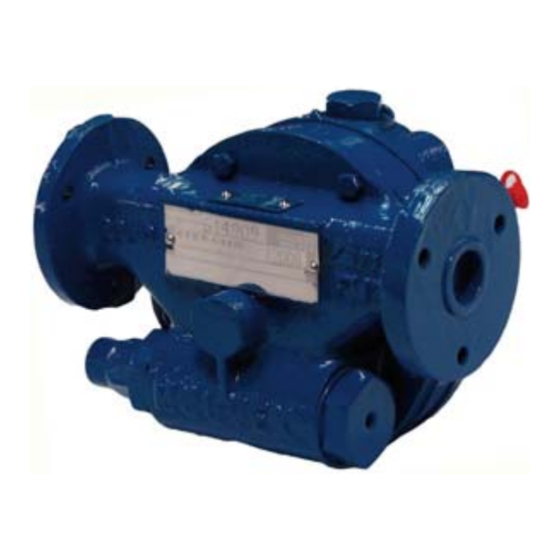Dover PSG Mouvex AZ O Installation, Betrieb und Wartung - Seite 17
Blättern Sie online oder laden Sie pdf Installation, Betrieb und Wartung für Water Pump Dover PSG Mouvex AZ O herunter. Dover PSG Mouvex AZ O 19 Seiten.

11. TROUBLESHOOTING (continued)
3
MEASURING THE VACUUM PRESSURE (as close as possible to the pump inlet, inlet side).
If the vacuum is high, e.g. higher than or equal to 6 to 7 metres WC (0.6 to 0.7 bara i.e. about 45 or
3-1
50 cm of mercury), this can result in pump noise. The cause could be :
a. the suction lift is too high (reduce it by taking the pump down closer to the level of the liquid)
b. the dynamic suction losses are too high :
3-1-1
1. cf 2-2-1 b
2. the inlet piping orifice is too close to the bottom of the tank.
3-1-2 The inlet piping is completely blocked (valve, tap, filter, cloth, full seal forgotten, etc.)
The liquid vapour pressure is too high (or has become too high following, for example, a change of tem-
perature). Bring the pump closer to the level of the liquid, install the pump closer to the feed or cool the
3-1-3
liquid to reduce the vapour pressure.
If the vacuum is low, for example, less than 3 metres WC (i.e. about 20 cm of mercury), check for leaks
3-2
on the inlet pipe, isolate the pump from the inlet piping (by closing the valve nearest the pump or by inser-
ting a full flange seal) and measuring the vacuum once again.
If the vacuum is high with the isolating valve closed on suction line, e.g. higher than or equal to 6 or 7
metres WC (i.e. about 45 to 50 cm of mercury), the pump is not the cause :
3-2-1
a. there must be an air inlet upstream of the pump isolating valve.
b. the liquid vapour pressure is or has become too elevated due to a change of temperature (cf 3-1-3).
If the vacuum is low or non-existent, the reason could be :
a. that the bypass valve is not closing properly, due to dirt on the valve seat.
b. air is entering the pump (check the front cover seals, flanges, etc...)
3-2-2
c. the pump is worn and the internal tightness is out of specification (the piston bushings are worn, worn
piston and cylinder, broken piston wear compensation springs, worn partition, broken shaft).
4
This heating can be caused by :
- excessive tension in the transmission (belt or chain) on the pump shaft (check the alignment of pulleys
4-1
and the correct tension of belts).
- excessive pulling on the pump flanges by the piping (in this case, it must have been necessary to force
4-2
the piping into position to connect it to the pump).
- poor alignment of the pump - due for example to 4-2 (the pump is partially or totally uncoupled, the
4-3
pump shaft and drive shaft are not aligned with each other).
- inadequate anchoring of the pump unit leading to deformation of the chassis (make sure that the chas-
4-4
sis is clear of the ground except for the 3 anchoring points).
4-5
- seizing of the bushings (cured product preventing lubrication and cooling, excess power, etc...).
The seal may leak if :
a. it was damaged during assembly (scratching on the shaft), damage to 'O'rings in seal,
5
b. it is incompatible with the product (chemical and mechanical aggression / abrasion of 'o' rings and seal faces),
c. it is worn through normal use.
The shaft is worn at the seal or does not rotate correctly due to poor alignment, excessive tension on the
6
transmission belts, chains, etc...
NT 1003-A00 09 18 AZ O e
ABNORMAL HEATING OF BEARINGS
LEAKING SEALS
17/19
